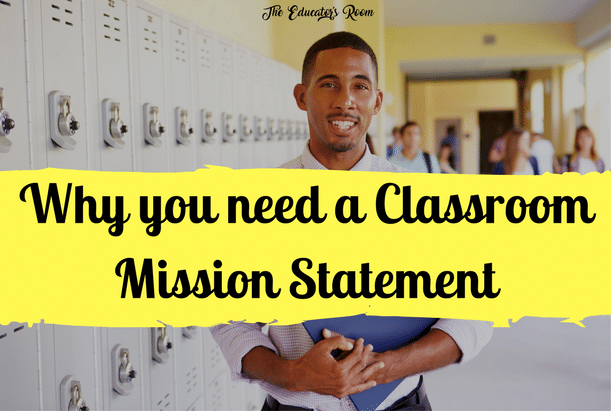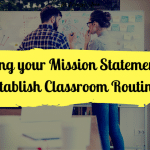A mission statement. The best businesses use them to guide direction and lead to success. Our classrooms are definitely not businesses — but I believe, like in business, that a classroom mission statement can lead us and our students toward a clear outcome, guided by a defined purpose.
I’ve created a teaching philosophy before. I’ve created student outcomes, both content- and skill-related. I share these with my students at the start of every term, and with parents at every Back to School Night. But once I go over them initially, the PowerPoint presentation gets closed, and these ideas are no longer in my face. Sure, I reference them verbally throughout the term — but there are a lot of them, and they are quite wordy and full of jargon, so I end up just spouting aphorisms.
[bctt tweet=”a classroom mission statement can lead us and our students toward a clear outcome, guided by a defined purpose.” username=”EducatorsRoom”]
This past August, at the eve of my fourth year teaching high school government, I revisited my philosophy and student outcomes. There has to be a better way! Enter, the mission statement: a succinct 1-2 sentences that summarizes your big goal(s) for your students, and how your classroom will support the development of those goals.
Accordingly, I was able to summarize all my outcomes and philosophy as such: “603 [my classroom] is a loving, welcoming, purposeful space where we work intentionally and efficiently toward becoming knowledgeable, efficacious citizens empowered to effect change in society.”
Why develop a classroom mission statement?
- It guides purpose and lends insight into your methods. By posting it in your classroom, you are affirming the “so what?” to students daily, and it can provide context for visiting other “stakeholders” (ahem, admin).
- It becomes an easy “elevator pitch” that briefly summarizes your entire teaching philosophy. This can help with your personal “branding” — to easily convey what makes you distinct as a teacher.
- It is a daily affirmation; a constant reminder of why you do what you do every day. Sometimes it sucks to be a teacher — and those are the days when we need to be affirmed in our purpose. The suffering is en route to a bigger successful outcome.
- All these reasons are even more important in today’s tumultuous political world, where a lot of things about our profession feel out of control. Having a mission statement helps us at least take control of our own classrooms.
I wrote my mission statement on the whiteboard closest to my desk, at the front of the room. This way I literally see the words every day, whether I am sitting during prep responding to emails, or when I am standing at the back of the room, giving directions to students on the upcoming activity. It allows me an opportunity for reconnection and reflection; and frankly, it drives me to be my best.
There is no one-size-fits-all formula for a good mission statement. It ought to come from the heart, each word perfectly considered for its additive value, and edited to eliminate all fluff. Before drafting a statement, I advise stream-of-consciousness journaling (which I lovingly call “brain barf”). Answer for yourself:
- What are the three main goals you have for your students? What do you want your students to be able to do upon completing your class?
- How do students build these skills/reach these goals? Think about your approach/reasoning behind homework, tests, projects, assessments, etc.
- How do you see the physical space that is your classroom? How does your classroom support your activities/lessons?
- What are the best compliments you have received as a teacher? (Either from students, peers, adult observers…) Why did those compliments stand out to you? Do they provide any insight into what you value as teacher?
After answering these questions, are there any words or phrases that pop out? It might be worth exploring some ideas deeper. Keep asking yourself “why” — Why do I assign that project? Because it helps students become better speakers. Why do I care if student become better speakers? Because they can get their point across better to others, and others will be more apt to listen to them. Why do I care if others value my students’ opinions? Because… Keep going down the rabbit hole until you strike gold. Look for adjectives that you constantly use. When I journaled, I found I kept using “efficacious” to describe my students — so I knew that word had to be in my statement.
[bctt tweet=”There is no one-size-fits-all formula for a good mission statement. ” username=”EducatorsRoom”]
When drafting the actual statement, consider (1) the physical space of your classroom, (2) what work happens in that classroom, and (3) what outcomes can be expected. Need help turning your “brain barf” into sentences? Pay attention to your oft-used adjectives, and feel free to use this fill-in-the-blank framework: “[Your classroom number] is a ______, _______, ______ space where we work _____ and _______ toward becoming _____________ [for what purpose?].”
Keep playing with different words until absolutely everything feels right. That you can defend and explain every single word included in that statement. Until you can read it and almost feel shivers, because it so perfectly encapsulates your purpose. Sleep on it if you need to. Set it down and return later. Use a thesaurus. But stay true to yourself.
I aspire for my students to know how they can change the world — and my mission statement helps me affirm that goal. I get to that goal by having a strictly-structured, routinized class with little-to-no homework — and my statement helps me affirm those methods. My classroom is full of nerdy decorations and collaborative seating arrangements — and my mission statement helps me affirm that environment.
What about you — do you have a mission statement? Has it helped you in any way? Please share your statements and pro-tips in the comments. After all, the best learning emerges from a community of learners.








This is really interesting. I have my teaching philosophy all through my classroom, my syllabus, and in daily activities. But I never put it into a mission statement, which I think would really help center my teaching philosophy. I’m going to do one now similar to yours above for my AP Gov class and maybe something a bit more radical social/racial justice based for Ethnic Studies.